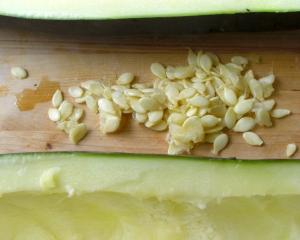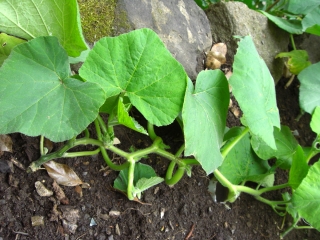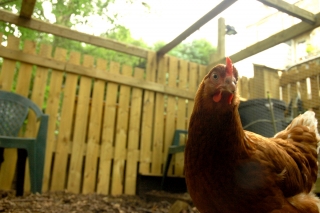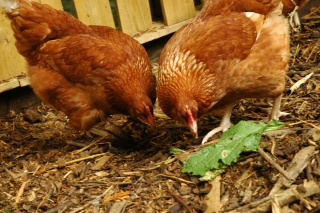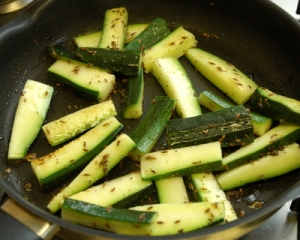Saving seeds from courgettes/marrows
As I mentioned in passing in my last post, we’re in the middle of a courgette-glut. Unfortunately the glut started in the second busiest week of my year (the summer showcase at drama – meaning I work about 60hrs instead of the usual 35hrs) so the courgettes didn’t get picked on time – and they stayed on the vine growing into marrows. I’d intended to let some of the fruits grow to marrow size anyway to collect seeds for next year so it wasn’t the end of the world.
I harvested one of the marrows yesterday – it weighed in at 1.8kg (just under 4lbs). I managed to slice a good number of the seeds in half while cutting it open (doh!) but still got 30 or 40 good size seeds from it. I’ve not saved the seeds from marrows before so I’m not sure whether or not it’ll be a success – the ones I’ve kept look fully formed and are the roughly the same size as the ones I bought this year (there were a lot of smaller ones which I discarded), but only time will tell if they’ll germinate.
When saving seeds, you’re supposed to leave the fruit on the plant for as long as possible to allow the seed to fully develop. Over ripe but not rotten is the usual guideline. This marrow was probably just edging toward over-ripe from ripe – still edible but the skin was tough (it’s over-ripe if you can’t push your thumbnail easily into the skin).
Anyway, I’ll see how these seeds dry and will try growing them next year – it feels like there is little to lose. I’ll let another couple of fruits stay on the plant longer to see what the difference is.
(Surprisingly/frustratingly, the chickens don’t seem to like courgette/marrow – a shame because there is a lot of it to go around!)
Read MoreLessons from our garden so far
As we only moved into our house last autumn, our first growing season has been one of experimentation – see what grows here, what doesn’t, and what else we have to contend with.
Here’s some of the lessons I’ve learned so far:
Butternut squashes take longer to germinate that most other things. I planted six seeds and a few weeks later, when everything else was well underway, I had just one sprout poking through the soil. Oh, I thought, that’s a really poor germination rate. Damn you, eBay seeds!. Then I planted another 40 (…) seeds with the hope of getting half a dozen plants. And a couple of days later, the original other five seeds sprouted. And then about 30 of the second sowing. I have a lot of squash plants this year.
(Ditto, to a slightly lesser extent, courgette plants. I had seven in my original planting then got some free seeds from BBC’s Dig In project and planted them too. After giving some away and losing some to one thing or another, I think we’ve currently got about 14 plants fruiting or about to fruit. Unsurprisingly, the self-germinating ones have been a lot more productive so far.)
Read MoreChicken update: one week on
I’m not going go on and on and on about the chickens but I thought I’d just do a quick update because it’s a week now since we got them – and we had a good bonding day yesterday.
The as-yet-still-unnamed girls seem to have settled in well. The first couple of nights, they needed a little encouragement to go to bed but now they go of their own accord. They were also sleeping in one of the nestbox in a big heap too but now they seem to be using the perches more.
Diet wise, they’ve shunned some of the scraps I’ve taken down – the bolted lettuce has been mostly rejected – but they like leftover pasta and nettles (which is good because there are *loads* in the field next to our house but I’m going to get better gardening gloves before I pick any more as the ones I had one yesterday weren’t good enough and ow-ee, stings all over). They’re eating borage leaves in this picture, which were also popular – handy since we’ve got a healthy patch of them in the herb bed.
Read MoreJohn’s Grandma’s marrow flower fritters recipe
I remember eating some of John’s Grandma’s marrow flower fritters at the very start of our relationship and so they always remind me of that exciting trying-new-things-with-a-new-person stage. I’d been thinking about making some with the courgette flowers we’ve had popping up over the last few weeks – when John’s mum arrived with a bag full of them last week.
While I encouraged our niece Mia to play ukelele and take photos of strange things, John and his mum whipped up a batch of fritters for lunch. Here’s the recipe – but unfortunately it’s a bit vague as it’s not been written down in their family for decades (if ever!) <- suggestions for revisions gratefully received!
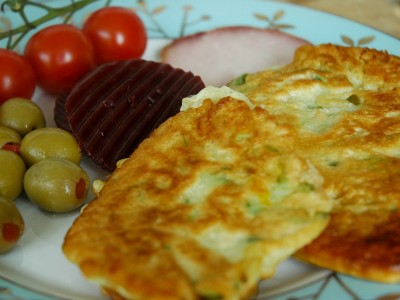
Ingredients (to make roughly 6 palm-size fritters)
Self Raising Flour about 2oz/50g per egg
The aforementioned egg or eggs
About 6 marrow flowers per egg
Some courgette/zucchini (optional but makes it more of a meal)
Pinch of salt
A little black pepper
A little water
Oil for frying
Method
Tear up the marrow flowers into pieces – size is up to you – anything from confetti size to about half the original petal size. If your plants are already fruiting, you can add a thinly sliced courgette (zucchini) to the mix too.
Mix the flour, egg, salt and water together to achieve the consistency of American pancake/drop scone batter – slightly thicker than usual British pancake batter.
Mix the flowers (and courgette, if you’re using that) into the batter.
Heat up some oil in a frying pan for shallow frying. (John & his mum used less oil when they made them and they stuck & burnt a bit.)
Drop a dollop of the batter-with-flowers into the hot oil and fry until golden brown. Flip over to cook the other side and serve immediately. John & his mum ground some more salt onto the top of the cooked fritters but that made them too salty for me – I’d have much preferred more pepper on top instead.
First courgettes from the garden
We picked our first courgettes from the garden on Friday night – the first thing we’ve harvested other than herbs and salad from the garden this year.
They’d been ready for picking for a couple of days but we weren’t ready to eat them – but on Friday, we picked some to have in our Mexican-ish dinner. I thought they tested a bit more courgettey than normal and stayed firmer during cooking. John was too busy cramming his mouth with nachos to say much about anything. Here, they’re frying with some cumin seeds and garlic – yum!
These were the first batch of seeds I planted – an early fruiter, although I’ve lost the seed packet so I don’t know exactly what they were. We’ve got five plants of those though and another five of the second batch, which have flowers on but no real fruit yet — there is a strong possibility we’ll be overrun with courgettes later in the summer!
Read MoreGrowing salad leaves – frugal, organic & green
 I just sowed my fourth pot of loose salad leaves of the season.
I just sowed my fourth pot of loose salad leaves of the season.
We finished the last of the just-about-to-bolt Winter Gems lettuce this week and have got a tray of Lollo Rosso seedlings in our porch/greenhouse but loose leaves has been filling the gap between those beautifully – and in three or four weeks, this new pot will be offering up its tasty leaves too.
Until we started growing our own, my partner John and I weren’t big salad eater, but mostly from disorganisation than anything. We didn’t have meal plans and we’d regularly find lettuce going soggy/brown in our fridge – we’d buy it for one meal, then eat some more at a second but then we’d have meals that didn’t work with salad or eat out, and soon the lettuce would be past it. We realised that didn’t make sense from a frugal or food waste point of view so tended to not have it at all at home, to save the waste.
Now though, from early spring to about the first frosts, we can eat fresh salad leaves whenever we want them – and without waste. A little gem lettuce is just the right size for a meal for us, or for a sandwich, we can just pick a handful of loose/”pick and come again” leaves.
Read More


